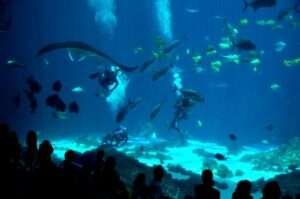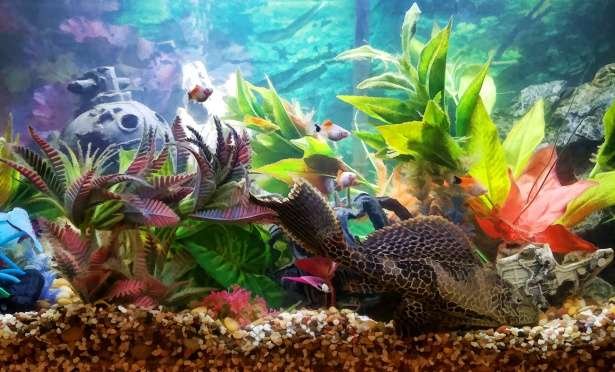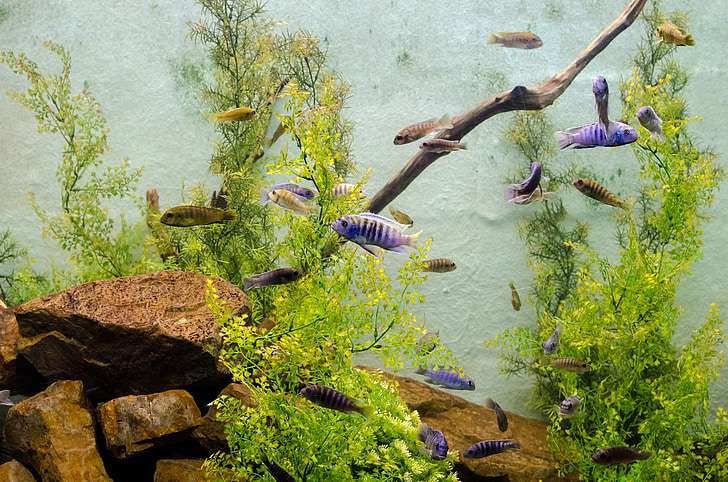FILTRATION OF SALTWATER AQUARIUM

It is very important to pick the right filtration system for your saltwater tank. Once a saltwater tank has been chosen, it must be set up by choosing the right filtration system. This is necessary to keep the water in your tank clean, which is good for your fish’s health. Bad water quality can stress out your fish and make them more likely to get sick. Bacteria, algae, and other impurities grow in these conditions, which is bad for the fish in your tank. Invertebrates are often the first to show that the water quality is bad. To protect the health of the animals in your tank, a good filtration system should keep the amounts of ammonia and nitrates low.
For good gas exchange and dissolved oxygen levels, the water also needs to move and circulate properly. It is especially important to keep the water moving in tropical saltwater tanks so that the fish don’t suffocate in the hot water. Moving water also helps to feed and care for the animals that live in the tank and gets rid of waste and silt that encourages the growth of harmful algae. Before picking out the right filtration system for your saltwater tank, you need to know the basics of how they work. You should think about three main types of filtering.
1. Mechanical Filtration
Most people know about mechanical filtering, but it is also one of the most important types. A mechanical filtration device separates waste that hasn’t been dissolved from the water. However, it doesn’t get rid of waste that has been dissolved, bacteria, algae, or other debris. To improve the quality of the water in an aquarium, mechanical filtration just gets rid of waste, extra food, plant matter, and dirt that are floating in the water. Most filters use filter floss, pads, or sponges that trap waste as the water flows through them to help clean the water. Water is forced through a sieve, which is made of filter media and catches any particles that are floating in the air and can’t get through.
2. Chemical Filtration
This is the next level up from the mechanical filter. It helps get rid of impurities that are dissolved in the water and can’t be seen. Chemical filtration systems, like those that use carbon or chemical resins, constantly remove toxins from the tank water until the filter is full. But the filter media stops working as well as it used to because it gets full of dissolved waste. Because of this, every three to four weeks, you should change your chemical filter media.
3. Biological Filtration
It’s very different from the first two types of filtering because the third one doesn’t actually filter anything. Nitrifying bacteria help break down waste in the tank and are a part of biological filtration systems. It is an organic filter that takes in oxygen and other things that don’t belong in the water. In biological filtration, good bacteria change organic matter that has been broken down into dangerous Ammonia and Nitrite into the safer compound Nitrate. This compound can then be removed by changing the water or using chemicals. Biological filtration is a slow process that usually takes four to six weeks to get going. You may have heard of “cycling” or the nitrogen cycle, which is another word for organic filtration. Before adding your fish, you need to set up a biological filtration system in your saltwater tank to make sure they will be safe and healthy. If you don’t have the system in place, your tank’s organic load might be too high for the good bacteria to handle. This could cause ammonia levels to rise, which could make your fish sick or kill them.
You should be able to see how all three types of filtration work together to make a good filtration system now that you know the basics of them. In your own saltwater tank, you should use all three types of filtration together to get the effects you want. Different kinds of media or plastics are put in the filter to make this happen. These materials get rid of dissolved wastes like fish waste that can make the tank water smell bad and change color. Phosphates, Nitrates, Ammonia, and many other toxins can also be taken out of the water by adding chemical media to the filter. A lot of the time, activated carbon is used to filter chemicals.
Now that you know everything you need to know, you should learn about the different kinds of filter systems for saltwater tanks. As you think about what your saltwater tank needs, keep these things in mind: different systems have different pros and cons. Most saltwater aquariums have one of three types of filtering systems: canister filters, wet/dry filters, or fluidized bed filters. To keep the water quality in a saltwater tank high, extra tools like protein skimmers are also very helpful.
Canister Filters
Canister filters are great for tanks that are 40 gallons or bigger because they can filter mechanically, chemically, and biologically. They have a plastic case that holds different kinds of filter media. The water from the aquarium is sucked into the cylinder by a siphon tube. The water is then pushed through filter media and back into the tank by a flexible pipe. Solid particles are caught by the filter media as the water flows through them, and dissolved wastes are screened out. Inside the filter, biological filtration media give good bacteria a place to live and multiply.
The best thing about a canister filter is how strong it is. These filters come in different sizes, and you can make them fit your tank by using different kinds of filter media. For those who want to keep a lot of fish or bugs, these are a good choice. One more benefit is that canister filters are self-contained, which means they can be kept in a cabinet under or behind the tank. They don’t need to be attached to the back of the tank like power filters do. The price of bin filters changes based on their size. For the best results with your aquarium, pick a good filter instead of a cheap one that you think will save you money because you’ll have to change it more often.
Wet/Dry Filters (Trickle Filter)
There are several reasons why a Wet/Dry filter, which is also called a trickle filter, is a great choice for saltwater tanks. These filters not only do a great job of biological filtration, but you can also make them fit your tank by adding different filter media and other parts to the sump system. It can be hard to set up a sump system for your wet/dry filter, but once it’s up and running, it won’t need much care. If you put a sump system with a wet/dry filter below the tank in an aquarium cabinet, it works like a canister filter. You can use siphon tubes to move water between the tank and the filter.
To help with biological filtration, wet/dry filters often have organic filter media inside them, like bioballs or floss. As water drips over the media, it creates a large air-to-water surface that pulls debris to the structure of the media. Chemical filtration media, like activated carbon, can help get rid of wastes that are dissolved in the water in the tank. Mechanical filtration media, like sponges, can get rid of solid waste. An overflow tank is another useful addition to your sump system. Its only job is to hold extra water so that your tank doesn’t overflow. You can add fresh water to this type of tank, and it will be filtered as you add it. This makes changing the water easier.
Even though wet and dry screens have many benefits, there are also some problems to think about. A lot of aquarium owners think that wet/dry screens are only good for fish tanks and not for reef systems because they produce nitrates. The bio-material inside the wet/dry chamber gets dirty over time. This causes nitrates to build up in the tank, which are not good for reefs. That being said, this might not be a problem if you keep your wet/dry filter in good shape and change the water regularly.
Fluidized Bed Filters
There are several ways in which a fluidized bed filter is not the same as a container filter or a wet/dry filter. These filters hang on the back of the tank, which is the main change. Pumping water from the tank into the fluidized bed filter forces it up through filter media made of sand, silicon chips, or plastic. This is because most fluidized bed filters don’t come with a power filter or pump, so you will likely need to buy one separately. This kind of filter is helpful because it has a lot of surface area for good germs to grow on. One bad thing is that the sand will finally pack down, which will make it harder for air to flow through the tank and lower the oxygen level. A fluidized bed filter doesn’t usually work well for chemical filtration.
One of the best choices for planted aquariums is a fluidized bed filter, which works well and doesn’t need much care. This is because it doesn’t remove important CO2. It takes longer for the bacterial bed to form, but once it does, it doesn’t need to be moved when maintenance is done, like other filtering systems do. These biological filters work very well and are fairly new. They use sand as the filter medium. The small bits give the bacterial colonies a lot of space to grow. The fluidized bed is a great biological filter that can be used in aquariums of any size, but it takes a little longer to get established at first. One thing to remember about these screens is that they might cost a lot. It could cost anywhere from $50 to $150 for a good one, and that doesn’t include the pump you’ll need to power it.
Protein Skimmers
These machines, which are also called “foam fractionators” or “absorptive foam separators,” use air bubbles to lift trash to the top of the tank and remove organic compounds from the water. The foam that is made is then put in a different area. This kind of filter is often found in reef tanks; it gets rid of dissolved contaminants before they can break down in the tank.
There are different kinds of protein skimmers, and each has its own pros and cons. In-tank skimmers are the least expensive, but they don’t give you as many choices. In-sump models, on the other hand, have more functions but cost more. People like the types that hang on the side of the tank because they are cheap and easy to set up.
Now that you’ve looked at the different filter choices, you should be able to pick one for your saltwater aquarium. The filter system’s job is to get rid of waste in the tank water and keep the water’s chemistry stable. What kind of filter you need for your tank will depend on its size, type, and the marine life that will live in it. The best place to find the right filter for your tank is to ask at a pet store nearby.


